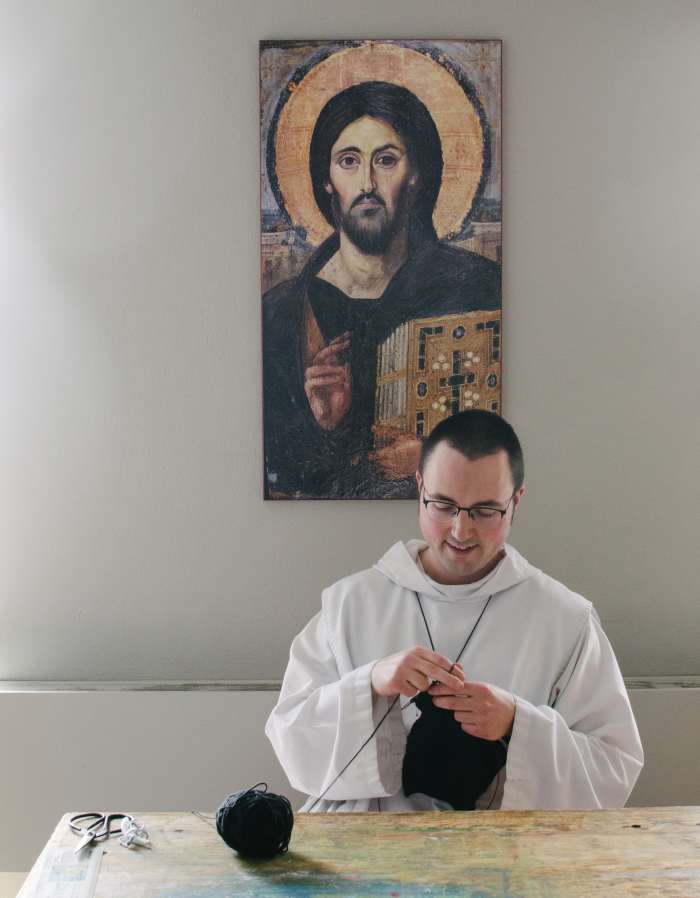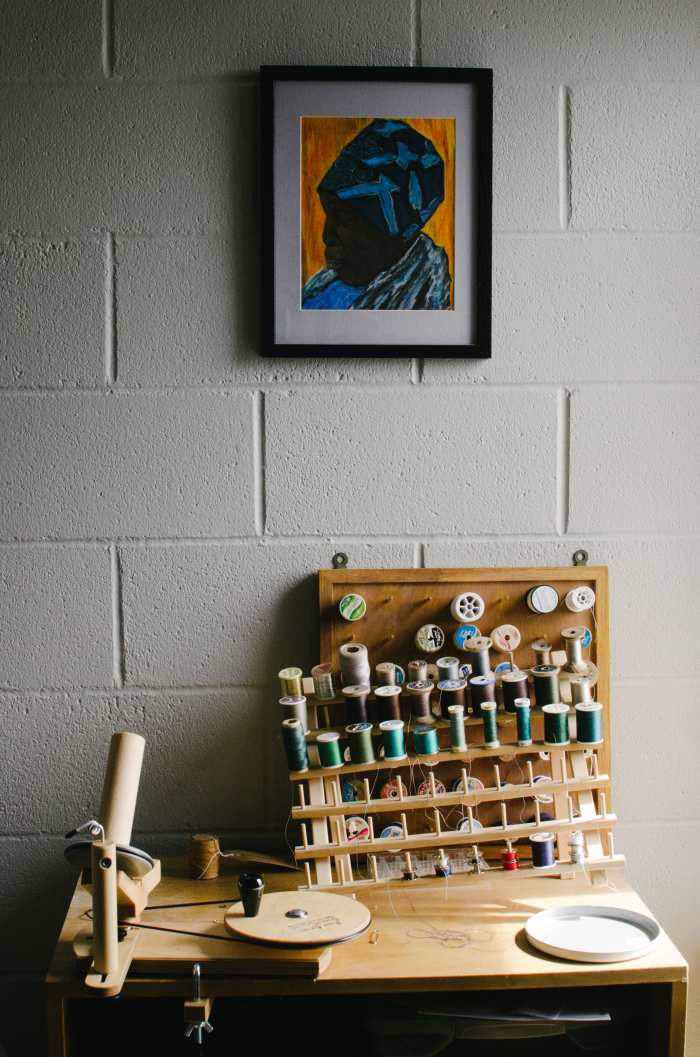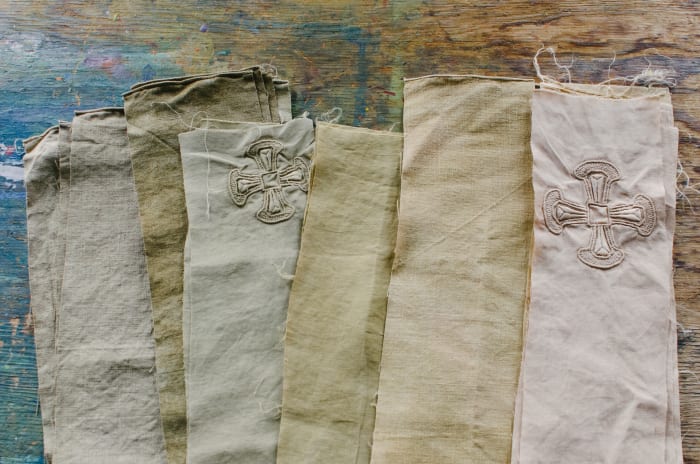A monk, an Episcopalian sister and a "ordinary clergy better half" talk about their experiences pursuing fabric arts and the Divine.
Brother Aidan Owen got into knitting because he vital a "wintry weather recreation."
A monk at Holy move Monastery in West Park, long island, Brother Aidan joined the order when he was 28 and immediately jumped into flower gardening as a means to contribute to his new neighborhood. but when bloodless climate pressured him indoors for a season, he discovered himself antsy for one more artistic outlet.
notwithstanding some might also imagine monks as figures from a bygone period, now-33-year-historical Brother Aidan grew to be a knitter the way many individuals his age do: through the cyber web. Brother Aidan relied on YouTube to assist him construct on the simple competencies he'd been taught through a roommate in seminary, found himself connecting with fellow enthusiasts on Instagram and generally fell into what he calls the "black hole of knitting online." finding Brooklyn Tweed, a corporation well-known for contemporary, "now not-your-granny's" knitting patterns, helped seal the deal.
Thanks for watching!seek advice from website"I simply fell in love," Brother Aidan says all through my consult with to his workplace at Holy pass, the place a part of a cable knit-sweater he made is framed and striking on the wall alongside a crucifix fashioned from reclaimed timber and a painted icon of the Virgin Mary.
Thanks for watching!seek advice from WebsiteThanks for observing!seek advice from web site
Brother Aidan knitting in his studio. photograph: Whitney Bauck/Fashionista
"It related so lots of these a lot of threads in my life as a result of i used to be truly plugging into the ecological points of spirituality," he explains. "I had my Christian spirituality, I had the ecological stuff, after which I had creativity and making things. And it all came collectively in knitting since you're actually apparel yourself with stuff from the earth."
Knitting quickly grew to become a gateway to all method of fiber arts, from plant-primarily based natural dyeing to stitching, as Brother Aidan delved deeper into the conversation around apparel construction and sought to create a wardrobe for himself that turned into "sustainable, own, ecologically sound and well made." listening to him focus on material sourcing — evaluating the price of organic cotton, linen, in the community-sourced wool or waste substances — it's clear that he'd healthy right in in most ethical fashion spaces, though he's not ever formally labored in the industry.
connected ArticlesWhy Millennial Catholics Are Re-Adopting the normal Chapel VeilIs Church Merch the subsequent massive element in Streetwear?The Met's 'Heavenly our bodies' demonstrate Has anything for Believers and Non-Believers Alike
For Brother Aidan, the gradual vogue flow's emphases on treating americans and planet with care have a right away connection to his knowing of what it capacity to are living a life in pursuit of the God he believes created the area. however there is additionally some thing about laboring over his personal garments that has modified the way he values garb even past the environmental point.
"You recognize the amount of labor that goes into whatever thing. I price these pieces in a totally dive rse approach than i would whatever keep-bought," he says. "there may be an attention and gratitude that develops for the apparel I have. and there is an appreciation of splendor — I believe it's a trademark of any sort of authentic spirituality."
This incorporation of splendor into one's experience towards the Divine is anything that makes intuitive experience to Thomas Roach, a fabric artist from Vancouver, Canada. Roach's work, which comprises liturgical vestments worn by way of monks and community sewing projects hung in cathedrals, flows from the conception that art can support worship. notwithstanding technically a layperson, Roach jokes that he's a "classic clergy spouse" in that his husband's an Anglican rector and Roach handles the creative arts offerings for their parish.
"The Anglican church is especially respectable, in my opinion, fo r celebrating elegance in worship," Roach says on the cell. "there may be lengthy been a sense that making issues celebrates the glory of God in creation... cathedrals were created to supply people with a little taste of heaven. Textiles have always been a part of that."
For Roach, that means growing group initiatives like quilts and wool-primarily based installation pieces that allow him to train parishioners to spin or sew or reveal-print, then striking the final collaborative items in church areas. it's additionally meant growing vestments for clergy to put on while conducting church features.
even though Roach asserts that he's "now not in fact oriented to the trend world," these wearable pieces have come to represent a significant part of his art practice, which has additionally been displayed in additional normal gallery settings. in many ways, he sees the vestments as an extension of indoors decor, pretty much like set pieces for a play.

A blue creation vestment via Thomas Roach, on exhibition at Museum London in Ontario. image: Courtesy Thomas Roach
"I even have a heritage in theater," he explains. "I see church as type of the identical thing: you might be creating a transformative journey that faucets into whatever deep. I suppose there is a certain amount of pageantry it really is linked to it, now not from a poor point of view, however from a sense that some thing vital is occurring... it be set apart and it helps us pay more consideration to it."
Vestments in selected are used to speak whatever in regards to the people main the services, Roach says. whereas one of the most noted churches in the world are led by using charismatic personalities who have become celebrities in their own appropriate (and who may well be familiar for their hypebeast tastes and high priced sneakers), the styles of church buildings Roach is commissioned through use vestments to create a a bit contrary impact.
"the first vestment is meant to make all of them seem alike in order that the uniqueness sort of disappears. it's in regards to the position that you're taking part in in framing the liturgy, not yo u as a person," Roach says. "And color signifies the place we are in the church calendar — what season we're in, what's the temper and tone."

Roach's vestments in use at Christ Church Cathedral in Vancouver. image: Courtesy of Thomas Roach
notwithstanding Roach asserts that he is not tremendous in tune with the broader "moral trend" neighborhood, he does r esonate with the style that so many contemporary sewists and knitters and herbal dyers emphasize moving slowly. That attitude invitations mindfulness into the process of growing, he says, rendering the making as potentially worshipful and meditative as the ultimate product should be as soon as it leads to a sacred space.
Sister Catherine Grace, a member of the community of the Holy Spirit in Brewster, new york, consents that the act of creating can itself be a gateway to religious experience. A longtime knitter, sewer, weaver and spinner, Sister Catherine Grace says the repetitive movement required for these initiatives are rhythmic in a method that pairs naturally with meditation. or not it's akin, in all probability, to the manner that many Catholics use rosary beads to support them pray — there may be some thing about protecting one's palms busy t hat may basically allow the mind to decelerate and focal point.
At age seventy three, Sister Catherine Grace comes from a special generation of material artists than Brother Aidan — she learned to stitch and knit at 4-H and a neighbor rather than from the cyber web. The fact that she's been an Episcopalian sister for 29 years capacity she's additionally witnessed a variety of alternate in how non secular orders method apparel.
"when I got here in we were wearing full habits and veils," she explains on the mobilephone. "It become a very natural spiritual order. once we begun farming and have been doing the entire farming ourselves, it wasn't practical to put on a dependancy... Now i am sitting here in leggings. it's now not the manner it became before. but you recognize, I consider essentially the most essential aspect is to find out how to are living the choicest lifestyles that you would be able to reside. and then when it be time to let go, just let go."

photo: Whitney Bauck/Fashionista
The forgiving approach Sister Catherine Grace talks about trade mirrors the forgiving nature of fabric arts themselves. if you make a mistake whereas portray or sculpting, you may need to scrap the entire venture and start over. but a sweater with a mistake may also be unraveled and its materials used once again with out the yarn going to waste. An embroidery will also be unpicked and the textile it a dorned will nonetheless be intact. A seam can be taken in and let loose once more to account for a physique whose form fluctuates over time.
it's now not challenging to look the appeal for americans who have developed their lives across the conception of a gracious God who is perpetually willing to forgive and mend brokenness.
"perpetually things are being taken apart and put again together in a new way. issues come, they go. That whole creative loop, I believe it be echoed if you are working with your hands," Sister Catherine Grace says. "I suppose there is might be a extra impending feel of holiness, attention of sacredness in growing as a result of this is what's going on within the divine world and in the universe."
issues of creativity, connection to the ambiance and the use of beauty to mark spiritual importance are only the tip of the iceberg when it comes to these three individuals's concepts about God, fiber arts and slow fashion. And for all of the wa ys they're exciting individuals, they're also carrying on an inventive and non secular lineage that goes returned centuries.

old altar cloths Brother Aidan coloured with herbal dyes made from avocado pits and onion skins for use as part of a quilt undertaking. picture: Whitney Bauck/Fashionista< /p>
Roach facets out that one of the most ideal herbal dye specialists were making tapestries for Medieval churches, the use of flora and minerals to create pieces that nonetheless display vibrant colorings hundreds of years later — proposing a compelling counterpoint to those that argue that (often toxic) artificial dyes are necessary to make clothing that is in reality colorfast. Brother Aidan notes that monasteries have traditionally been facilities of apparel construction because of their emphasis on arts and self-sufficiency, reminding us even within the face of modern globalization that actually localized economies are really viable.
And for Sister Catherine Grace, all of it points again to the concept that spirituality isn't handled as something fully separate from lifestyles on a material plane, however that the two should be deeply intertwined with one one more. A sister's knit socks or a clergy significant other's embroidered vestments or a monk's self-sown < a href="https://fashionista.com/tag/deadstock">deadstock pants can feature, in their personal little techniques, as artistic assertions that human beings exist because the solidarity of soul and body, and that a lifetime of religion should honor and attend to both elements of existence.
"there's anything about being directly, bodily worried with the be counted part of the universe, since it's related so deeply to the power part as well," Sister Catherine says. "I believe it takes these two things for the holy to be made take place."
Homepage image: Whitney Bauck/Fashionista
No comments:
Post a Comment